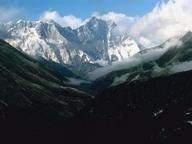Quiz Answer Key and Fun Facts
1. For most mountaineers and trekkers in the region, this major Nepalese city is the first stop in Nepal on your Everest quest. What city is this?
2. To get to Base Camp, on the South Route, you will have to trek across what glacier mass?
3. After strapping on your crampons, you will set out through one of the most dangerous sections on the climb. You'll have to cross bottomless crevasses on ladders, climb up huge ice walls, and pass under towering seracs. Where are you?
4. Before settling in at Camp I, you will have to rest. However, you will soon begin an ascent toward the summit through a large, eerily silent, open valley, surrounded on all sides by Himalayan giants. The sun and heat can be unmerciful. Avalanches and rock slides are common. Where are you?
5. After reaching Camp II, you will settle in for your next step in the climb. This will require an almost vertical ascent up a wall of ice, snow, and stone. Where are you?
6. Before clearing your ascent on this face, you must first cross a yellow layer of dangerous sandstone called the Yellow Band. After crossing the Yellow Band, you must cross this ridge-like buttress named after a city in Switzerland. Where are you?
7. After spending a night at Camp III, it is starting to get serious. You are now going to venture into the "Death Zone". By now, you are breaking out supplemental oxygen. You are on your way to Camp IV. Where is Camp IV located?
8. You don't get much rest at the South Col. You constantly use supplemental oxygen. You'll begin your summit attempt around 11:00 p.m. If you are lucky, at daybreak, you will find yourself at 27,600 feet at this prime location to rest. Where are you?
9. You press on, and you see the summit. As your legs burn and your lungs ache, you reach the top of the rise. However, you see that you still have a long way to go. Fooled! Where are you now?
10. It is time for a somewhat easy walk across an exposed ridge of ice, rock, and snow. Be careful. One wrong step, and it is a long way down. Where are you now?
11. Finally, you have arrived at the most technical and dangerous point on the upper mountain. You must navigate a 40 foot crag of rock, the only thing blocking your way to summit. This crag is named after a famous Everest pioneer. What is the name of this obstacle?
12. Take a look! You are at the top of the world. You do not want to spend all day here, but you will probably want to document your success. At the summit of Everest, how much oxygen is there compared to the amount at sea level?
13. Many physiological ailments could have ended your climb at any time. Altitude sickness is a major concern, as it can affect even the most seasoned climbers. Altitude sickness comes in two forms commonly referred to as "HACE" and "HAPE". What do these abbreviations stand for?
14. Without these indigenous people of the region, you probably wouldn't have been successful in your climb. They serve as porters, sirdars (or managers), and guides. They often climb without the aide of supplemental oxygen. Who are the unsung heroes of the region?
15. You may want to thank the blessing and prayer ceremony, or puja, before the climb for part of your amazing luck. Most likely, you prayed to the Tibetan god who supposedly lives on Everest. What is the name of this god?
Source: Author
dmbfanatic
This quiz was reviewed by FunTrivia editor
Exit10 before going online.
Any errors found in FunTrivia content are routinely corrected through our feedback system.
